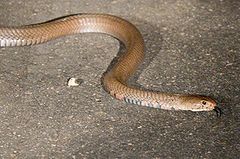- Mozambique Spitting Cobra
-
Mozambique Spitting Cobra or Mfezi 
In Kruger National Park, South Africa Scientific classification Kingdom: Animalia Phylum: Chordata Class: Reptilia Order: Squamata Suborder: Serpentes Family: Elapidae Genus: Naja Species: N. mossambica Binomial name Naja mossambica
Peters, 1854Synonyms Naja nigricollis mossambica Peters, 1854
The Mozambique Spitting Cobra (Naja mossambica) is a type of cobra, native to Africa.
Contents
Description
In color the snake is slate to olive grey, olive or tawny brown above, with some or all scales black-edging. Below, salmon pink to purple yellowish, with black bars across the neck and ventrals speckled or edged with brown or black; young specimens sometimes have pink or yellow bars on the throat.[1][2]
The average length of adults is between 900mm - 1,050mm (2½-3 feet), but largest specimen actually measured was a male 1,540mm (4 feet) long. (Durban, Kwa-Zulu Natal, South Africa]).[2]
Distribution
This species is the most common cobra of the savanna regions of the tropical and subtropical Africa. The distribution includes Natal, Low veld south-eastern Tanzania and Pemba Island and west to southern Angola and northern Namibia. Younger specimens are much more frequently encountered in the open at daytime. Unlike the Egyptian Cobra, this species prefers localities near water, to which it will readily take when disturbed.[2]
Toxicology
It is considered one of the most dangerous snakes in Africa. Like the Rinkhals, it can spit its venom. Its bite causes severe local tissue destruction (similar to that of the puff adder). Venom to the eyes can also cause impaired vision or blindness.[2]
Diet
This cobra's diet mainly consists of amphibians, other snakes, birds, eggs, small mammals, and even insects occasionally.[2]
Habits
This snake is nervous and highly strung. When confronted at close quarters this snake can rear up to as much as two-thirds of its length, spread its long narrow hood and will readily "spit" in defense, usually from a reared-up position. By doing this the venom can be ejected at a distance of 2-3 metres (5½ - 8¼ feet), with remarkable accuracy. The spitting cobra does bite depending on its environment and the situation it is in, and also shares the same habit with the Rinkhals of feigning death to avoid further molestation.[1]
When in a confined area like a tube the reptile will bite instead of spit.
Reproduction
The eggs average 10 to 22 in number, hatchlings measure 230-250mm.
References
- ^ a b Carruthers, Vincent (2005). The Wildlife of Southern Africa: A Field Guide to the Animals and Plants of the Region?. Struik. p. 100. ISBN 9781868724512.
- ^ a b c d e Branch, Bill (1998). Field Guide to the Snakes and Other Reptiles of Southern Africa. Ralph Curtis Publishing. p. 109. ISBN 978088359042.
Categories:- Reptiles of Africa
Wikimedia Foundation. 2010.
